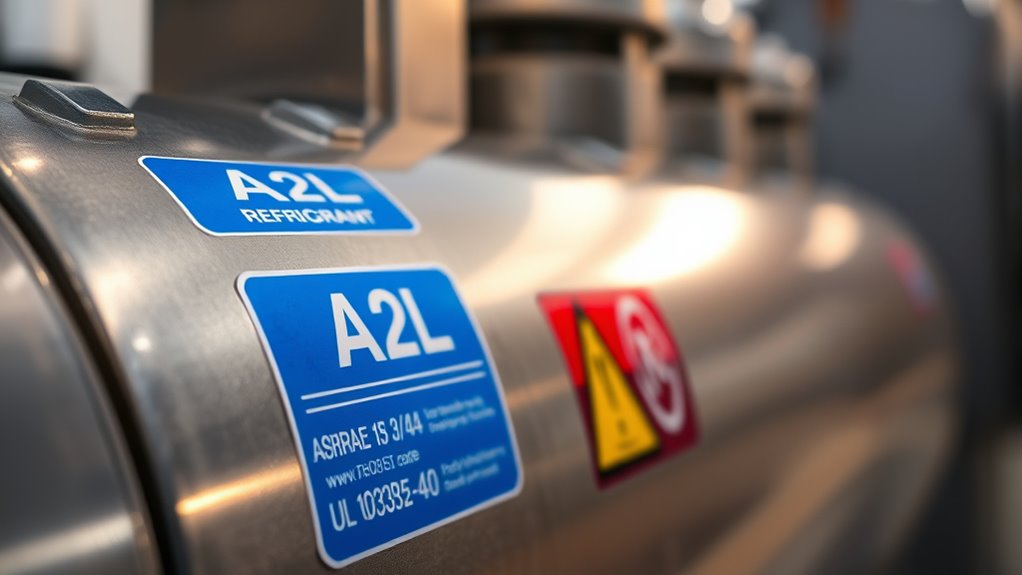If you’re working with A2L refrigerants, it’s crucial to understand the safety standards that govern their use. ASHRAE 15 and 34 set guidelines for safe handling, leak detection, and system design, especially for low-flammability refrigerants. UL 60335‑2‑40 outlines safety requirements for equipment, including electrical safety and leak mitigation. Staying compliant ensures safety and efficiency, and exploring these standards further can help you implement best practices confidently.
Key Takeaways
- ASHRAE 15/34-2024 sets safety standards for A2L refrigerants, including charge limits, ventilation, and leak detection requirements.
- UL 60335‑2‑40 certifies HVAC equipment safety when using A2L refrigerants, focusing on electrical safety and ignition risk mitigation.
- Proper sensor placement and leak detection systems are mandated to prevent flammable refrigerant accumulation per these standards.
- A2L refrigerants’ classification and safety protocols help ensure compliance with regulatory codes and environmental safety.
- These standards collectively guide system design, installation, and operation to minimize fire and health risks associated with A2L refrigerants.
Understanding the A2L Classification and Composition

Understanding the A2L classification starts with recognizing how it reflects both safety and flammability characteristics. It’s based on the ASHRAE 34 standard, indicating low toxicity (rated “A”) and mild flammability (“2L”), with slow burning velocity. The “L” suffix shows these refrigerants are less flammable than higher classes like A3. A2L refrigerants, including pure HFOs like R-1234yf and R-1234ze, or blends of HFCs and HFOs such as R-454B, are designed to have low GWP and zero ozone depletion potential. Their molecular structures, especially fluorine placement and double bonds, influence flammability limits and combustion speed. These refrigerants are safer alternatives, suitable for various applications, and meet updated safety standards like UL 60335‑2‑40, with added safety measures and controls. Additionally, understanding the chemical composition of A2L refrigerants helps in evaluating their flammability and environmental impact. Recognizing the flammability limits associated with these refrigerants enables better safety management and proper handling procedures in their applications.
Updates in ASHRAE 15 and 34 for A2L Refrigerants

Recent updates in ASHRAE 15 and 34-2024 introduce more rigorous safety standards for A2L refrigerants, emphasizing controlled charge limits, enhanced ventilation, and precise classification criteria. The standards now specify stricter refrigerant classification based on mild flammability and clearer charge restrictions tied to space volume and ventilation conditions. You’ll need to carefully calculate maximum refrigerant charges using standardized formulas and display clear labeling on equipment. Ventilation requirements are heightened, demanding increased air exchange rates and leak detection systems in spaces with A2L refrigerants. Plus, the standards incorporate UL 60335‑2‑40 safety protocols, focusing on electrical safety, leak mitigation, and system protections. These updates ensure safer handling and installation, aligning building codes and mechanical standards to better manage A2L refrigerant risks. Furthermore, refrigerant safety classifications are now more clearly defined to assist in proper system design and compliance. Additionally, considerations from bedroom design principles, such as proper ventilation and safety, can be metaphorically applied to ensure optimal environmental conditions in systems utilizing A2L refrigerants.
Significance of ASHRAE 15 and 34 Standards for Safety and Usage
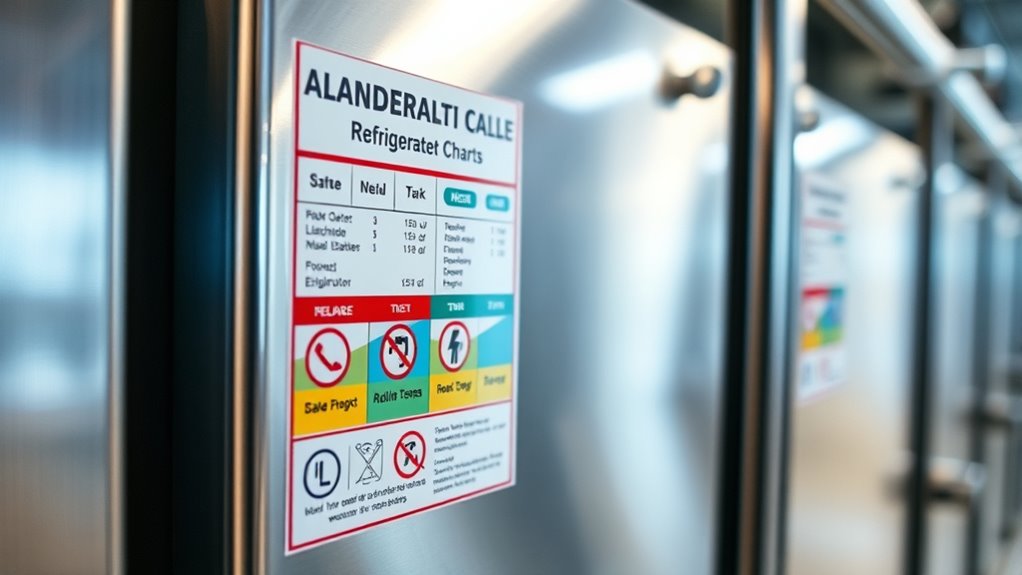
The ASHRAE 15 and 34 standards play an essential role in guaranteeing safe refrigerant use by providing clear classification and safety guidelines. These standards help you understand refrigerant toxicity and flammability, guiding safe system design and operation. They establish maximum allowable concentrations in occupied spaces, protecting people from health and fire hazards. The classification system assists you in evaluating risks, selecting appropriate safety measures, and maintaining regulatory compliance. Standard 15 also defines occupancy-specific safety requirements, leak detection, ventilation, and alarm systems that keep environments safe. Additionally, these standards promote consistent safety practices across the industry, ensuring a unified approach to refrigerant safety. By adhering to these standards, you ensure your refrigeration systems are designed, installed, and maintained to minimize hazards. They serve as a critical foundation for safe refrigerant handling, aligning safety practices with industry and regulatory expectations. Understanding regulatory compliance is vital for ensuring ongoing safety and legal adherence in refrigeration operations.
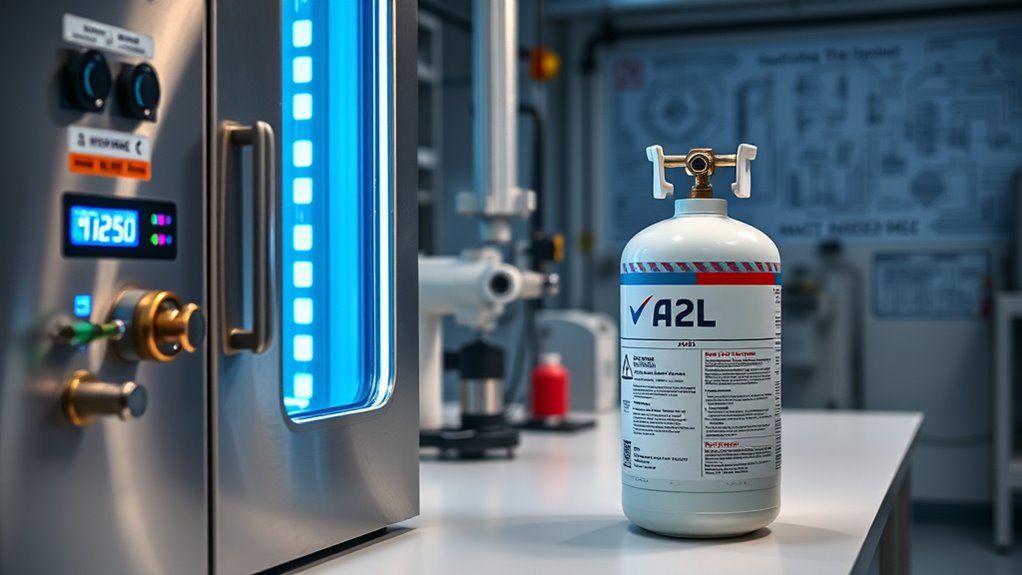
UL 60335-2-40 sets strict safety testing and design standards for HVAC equipment using A2L refrigerants. You need to guarantee that your products meet these requirements to minimize fire risks and ensure safety. Understanding these standards helps you develop compliant, safe, and efficient HVAC systems. Additionally, adherence to Vetted – Halloween Product Reviews ensures product quality and safety compliance. Incorporating safety standards for refrigerants into your design process enhances overall system reliability and compliance with regulatory requirements.
Safety Testing Requirements
Are your refrigerant systems compliant with UL 60335-2-40’s safety testing requirements for A2L flammable refrigerants? This standard mandates rigorous testing of all electrical components and assemblies to ensure they pose minimal ignition risks. You must verify that parts used in your equipment pass flammability and ignition risk tests, especially under fault conditions. The standard also requires internal ignition source prevention through flame risk testing, ensuring components won’t spark or overheat. Additionally, your system’s design must include leak detection systems if refrigerant charges exceed specified limits, capable of activating fans to dilute leaks quickly. These measures protect occupants and prevent dangerous refrigerant concentrations. Proper appliance maintenance plans are essential to identify potential safety issues early. Ensuring compliance with flammability testing can help prevent costly recalls and safety hazards. Compliance guarantees your equipment’s safety and reliability, aligning with industry standards and avoiding regulatory penalties.
Equipment Design Standards
Ensuring your HVAC equipment complies with UL 60335-2-40 involves integrating refrigerant detection systems (RDS) that can reliably identify leaks and activate control measures. These systems, whether factory- or field-installed, must detect pressure loss and trigger actions like shutting off compressors or activating fans to dilute leaked refrigerant below flammability levels. Proper sensor placement is critical; verification or adjustment may be necessary after installation to ensure effectiveness. The standard also limits refrigerant charges based on room volume, applying a safety factor of four to prevent flammable concentrations. Additionally, all internal electrical components must be free from potential ignition sources and certified for flame risk reduction, ensuring safety in residential and light commercial applications. Trailer music These design standards balance safety, performance, and compliance with North American requirements. Implementing appropriate safety measures is essential to meet the strict requirements of refrigerant classification standards.
Safety Measures and Leak Mitigation Strategies for A2L

To effectively manage the safety risks associated with A2L refrigerants, implementing thorough leak detection and mitigation strategies is essential. You should install advanced leak detection systems integrated into your HVAC setup to provide early warnings and prevent flammable gas buildup. Automatic shutoff valves can immediately stop refrigerant flow if a leak occurs, minimizing risk. Continuous monitoring sensors are especially important in enclosed or low-ventilation areas to detect refrigerant concentrations near flammability limits. Ensure your leak detection systems comply with standards like ASHRAE 15. Proper ventilation is critical—designed to quickly dilute leaks and prevent dangerous concentrations. Additionally, electrical components must meet explosion-proof standards, and regular inspections are necessary to maintain system integrity and safety in environments with A2L refrigerants. Studies indicate that proper safety protocols significantly reduce the risk of accidents and ensure compliance with safety standards. Implementing refrigerant safety regulations helps safeguard personnel and property from potential hazards.
Environmental and Regulatory Motivations for A2L Adoption
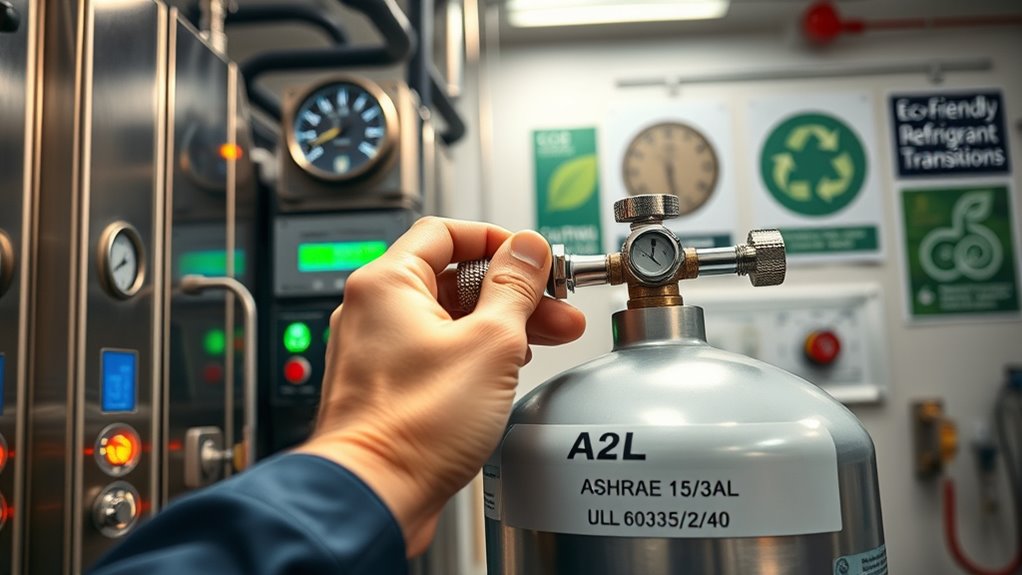
The push for safer leak detection and mitigation in A2L refrigerants is closely linked to broader environmental and regulatory drivers. A2L refrigerants have a lower global warming potential (GWP) than traditional options like R-410A, helping reduce greenhouse gas emissions. International agreements such as the Montreal Protocol and Kigali Amendment emphasize the need to phase out high-GWP gases. Regulatory frameworks, like the EPA’s AIM Act, accelerate this shift by mandating refrigerants with GWP below 700 starting in 2025. These policies aim to cut HFC use by 85%, encouraging industry adoption of environmentally friendly options. Additionally, switching to A2L refrigerants supports energy efficiency, leading to lower operational costs and energy consumption, aligning industry practices with global sustainability goals. Incorporating refrigerant safety standards ensures that as industry transitions, safety and compliance are maintained alongside environmental benefits. Implementing compliance measures enhances the overall safety and reliability of systems using A2L refrigerants.
Common A2L Refrigerants and Their Application Performance
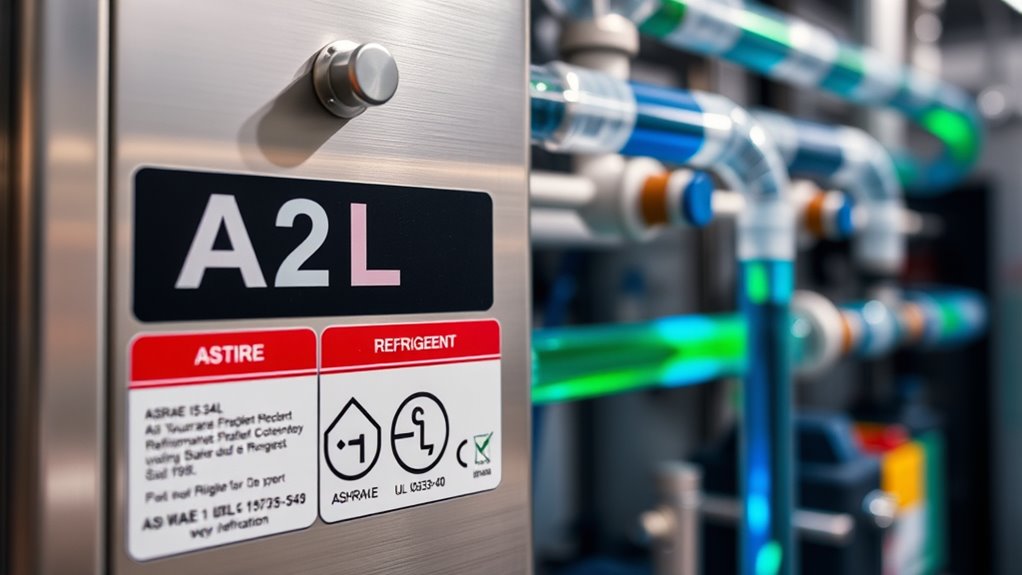
Common A2L refrigerants vary in composition and application, offering tailored solutions for different HVAC and refrigeration needs. R-32, a pure HFC, is popular in residential AC and mini-splits, with a GWP of 675. R-454B, a blend with HFO, serves as an R-410A alternative in whole-home systems, with a GWP of 466. R-1234yf, an HFO, is primarily used in automotive AC due to its ultra-low GWP (<1). R-455A (Solstice L40x), mildly flammable with a GWP of 146, suits commercial refrigeration. R-452B and R-454C, HFC/HFO blends, are common in commercial refrigeration and light commercial AC. These refrigerants deliver high energy efficiency, lower toxicity, and reduced flammability, making them suitable for a variety of applications while aligning with evolving safety and environmental standards.
System Design and Installation Considerations for A2L Refrigerants

Designing and installing systems that utilize A2L refrigerants require careful attention to safety features and regulatory compliance. Leak detection systems must include sensors capable of identifying low-level refrigerant leaks in occupied and machinery areas, triggering alarms and safety measures instantly. Proper placement within refrigerated cases and walk-in units ensures quick leak localization. Safety shut-off valves (SSOVs) should be precisely positioned to isolate leaks without disrupting the entire system, with calculations demonstrating adherence. Adequate ventilation, with sensors and automatic controls, disperses flammable gases effectively, maintaining concentrations below flammability limits. refrigerant classification helps in designing systems that meet safety standards and environmental regulations. Additionally, understanding system design principles is essential to optimize safety and efficiency when working with A2L refrigerants. Electrical components must be certified or enclosed to prevent ignition. Proper integration of these elements ensures safe, compliant operation of A2L systems.
Future Trends and Regulatory Developments for A2L Safety Standards
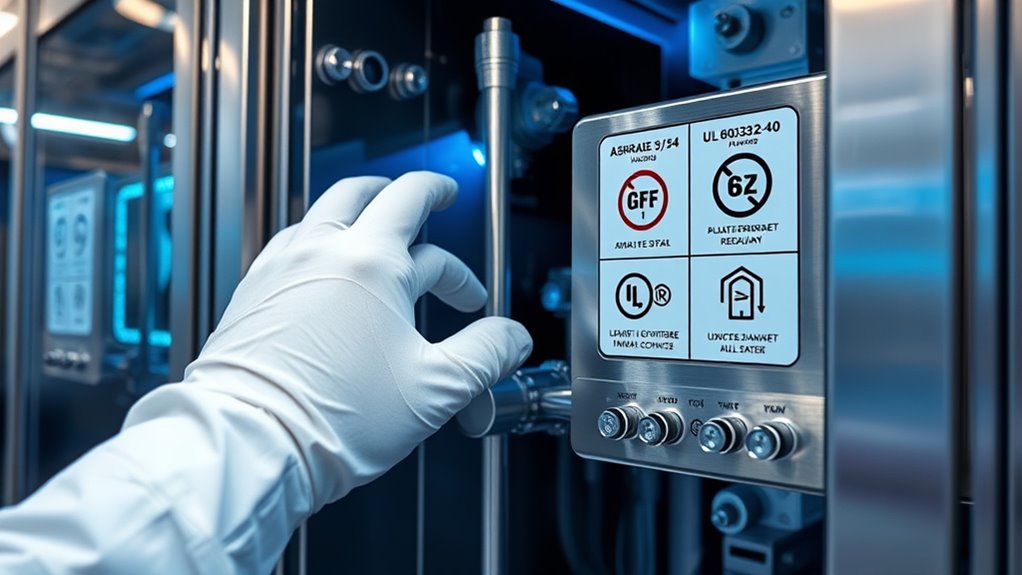
Emerging regulations are rapidly shaping the future of A2L safety standards, driven by stricter GWP limits and enhanced safety requirements. By January 1, 2025, mandates in North America require new HVAC systems to use refrigerants with GWP below 700. Updated ASHRAE standards 15-2024 and 34-2024 now specify safety, classification, and installation rules tailored for mildly flammable A2L refrigerants. UL 60335-2-40 certification is becoming mandatory, ensuring electrical and fire safety compliance. Governments offer incentives and set phase-out timelines targeting high-GWP refrigerants like R-410A, favoring low-GWP options such as R-454B. Future standards will likely harmonize globally, with ongoing efforts to align safety codes and extend regulatory support to accelerate the transition to safer, environmentally friendly refrigerants. Recognizing the importance of safety standards in protecting both consumers and the environment, industry stakeholders are actively collaborating to develop comprehensive regulations that promote innovation while ensuring safety. Additionally, advancements in fraud detection techniques are enhancing the integrity of the certification process, helping to prevent counterfeit or non-compliant products from entering the market.
Frequently Asked Questions
How Does A2L Refrigerant Flammability Compare to A2 or A3 Types?
You’ll find that A2L refrigerants are less flammable than A2 or A3 types. They need higher concentrations to ignite, require more energy to catch fire, and burn slower with less heat release. This makes A2L safer to handle and use in many applications. The lower flammability risks mean you can often use larger charges and less strict electrical safety measures compared to more flammable A3 refrigerants.
What Specific Safety Measures Are Required for A2L Refrigerant Leak Detection?
Think of leak detection as your system’s vigilant guardian. You need electronic leak detectors set to thresholds at 10% and 25% of the flammable limit, placed near leak-prone spots like the bottom of confined spaces. Incorporate safety shut-off valves, guarantee proper ventilation, and connect detectors with your building management system for real-time alerts. These measures act as your safety net, catching leaks before they turn into hazards.
Are Existing HVAC Systems Compatible With A2L Refrigerants Without Modifications?
Your existing HVAC systems aren’t compatible with A2L refrigerants without modifications. Legacy units designed for A1 refrigerants, like R-410A, lack the necessary safety features and certified components needed for A2L’s mild flammability. To guarantee safety and code compliance, you’ll need to replace or extensively upgrade systems, including controls, coils, and safety devices, to meet A2L standards. Partial retrofits aren’t recommended or usually permitted.
How Do A2L Refrigerants Impact System Performance and Efficiency?
A2L refrigerants enhance your system’s performance and efficiency by offering better thermodynamic properties, allowing for quicker cooling and more precise temperature control. They operate at higher pressures, improving heat transfer and enabling more compact, space-saving designs. You’ll see energy savings of up to 15%, lower operational costs, and reduced environmental impact. Although system modifications for safety are necessary, these refrigerants ultimately lead to more reliable, efficient, and eco-friendly HVAC operation.
What Are the Long-Term Safety and Environmental Benefits of A2L Adoption?
Think of adopting A2Ls as planting a sturdy, eco-friendly tree for the future. You’ll benefit from long-term safety since these refrigerants are non-toxic, mildly flammable, and require high ignition energy, reducing risks. Environmentally, they lower global warming potential and support regulatory compliance. Over time, they help create a safer, greener world, while your systems stay efficient and compliant, making a lasting positive impact on safety and the planet.
Conclusion
Think of A2L refrigerants as a delicate flame—powerful yet requiring careful handling. By understanding the standards like ASHRAE 15/34 and UL 60335-2-40, you’re safeguarding this spark, ensuring it illuminates safely without causing harm. Embrace these guidelines as your shield and compass, guiding your system’s design and safety measures. With responsible management, you keep the flame alive—bright, efficient, and safe for everyone.
